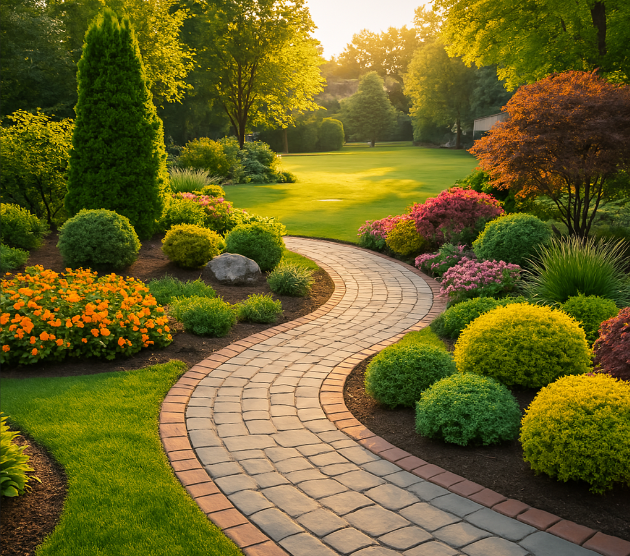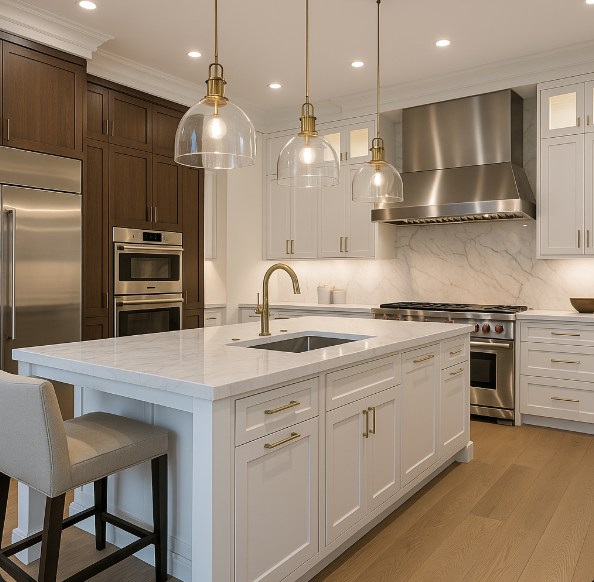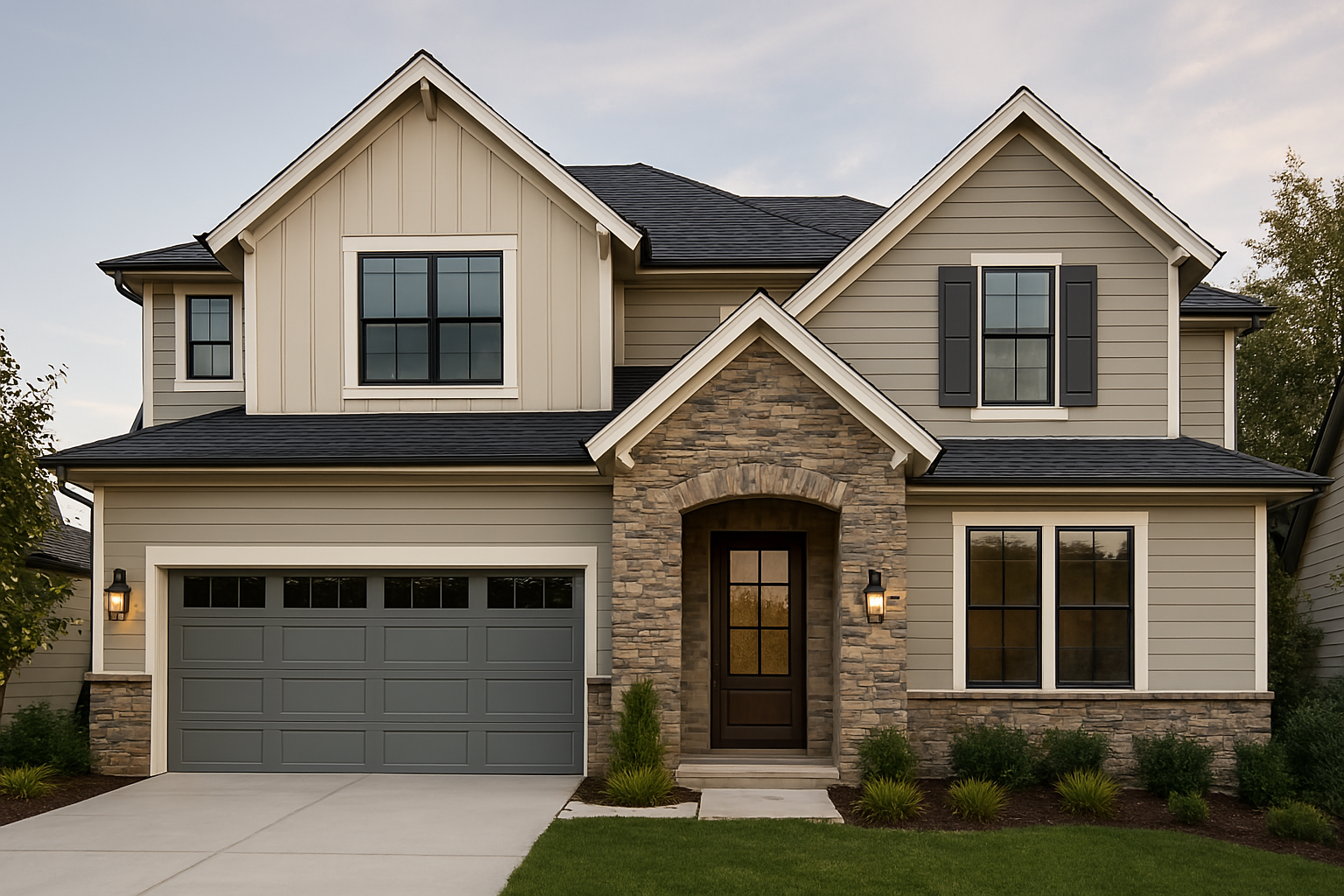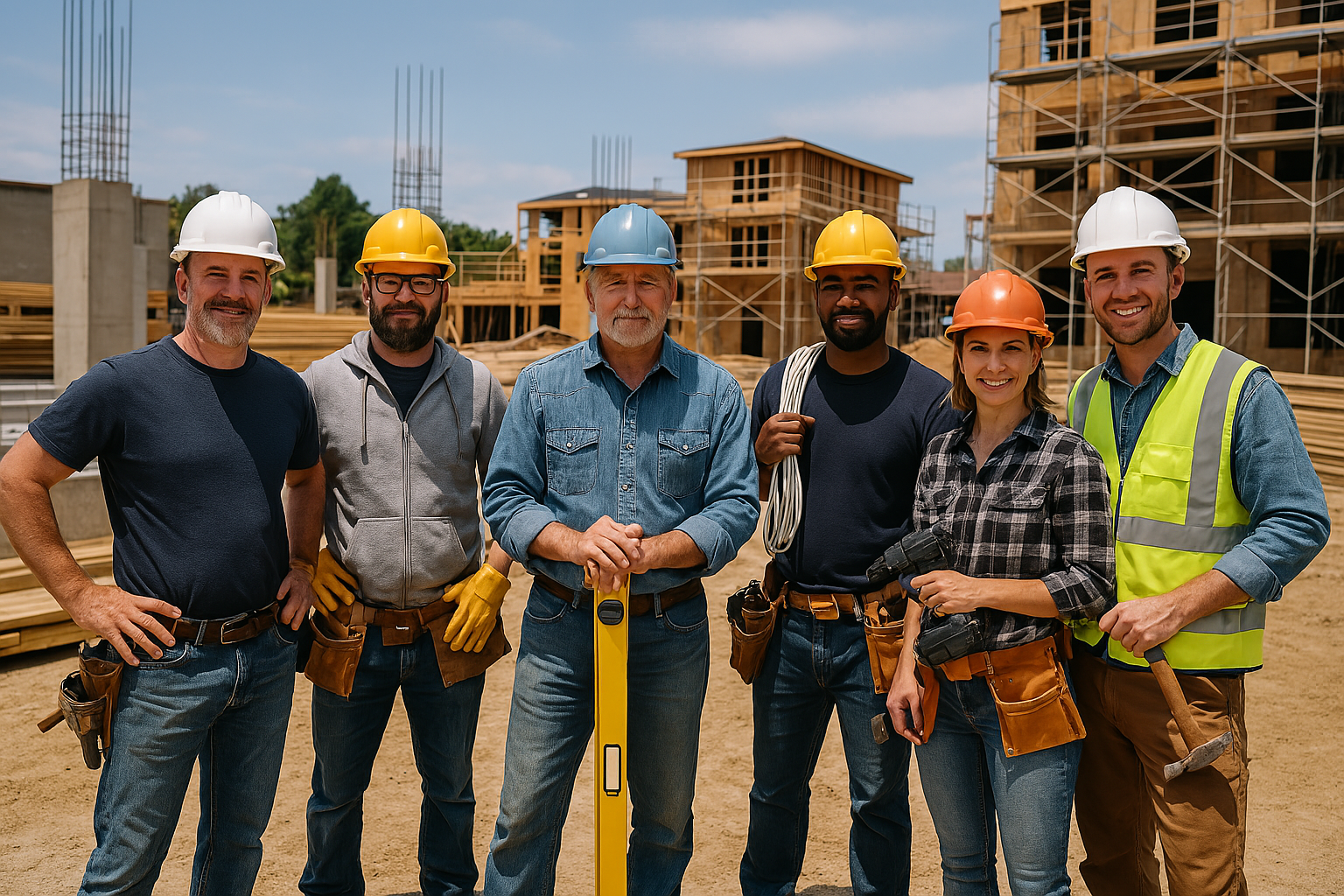
Check out our app!
Explore more features on mobile.
Landscaping: Transform Your Outdoors into a Beautiful Space
Landscaping creates essential outdoor living space that enhances property value and lifestyle quality. Research shows that professional landscaping can increase property values by 15-20% and deliver an ROI of 150-175% at resale. This comprehensive guide explores landscape design principles, installation techniques, and expert strategies to ensure your outdoor space delivers maximum beauty, functionality, and environmental benefit.
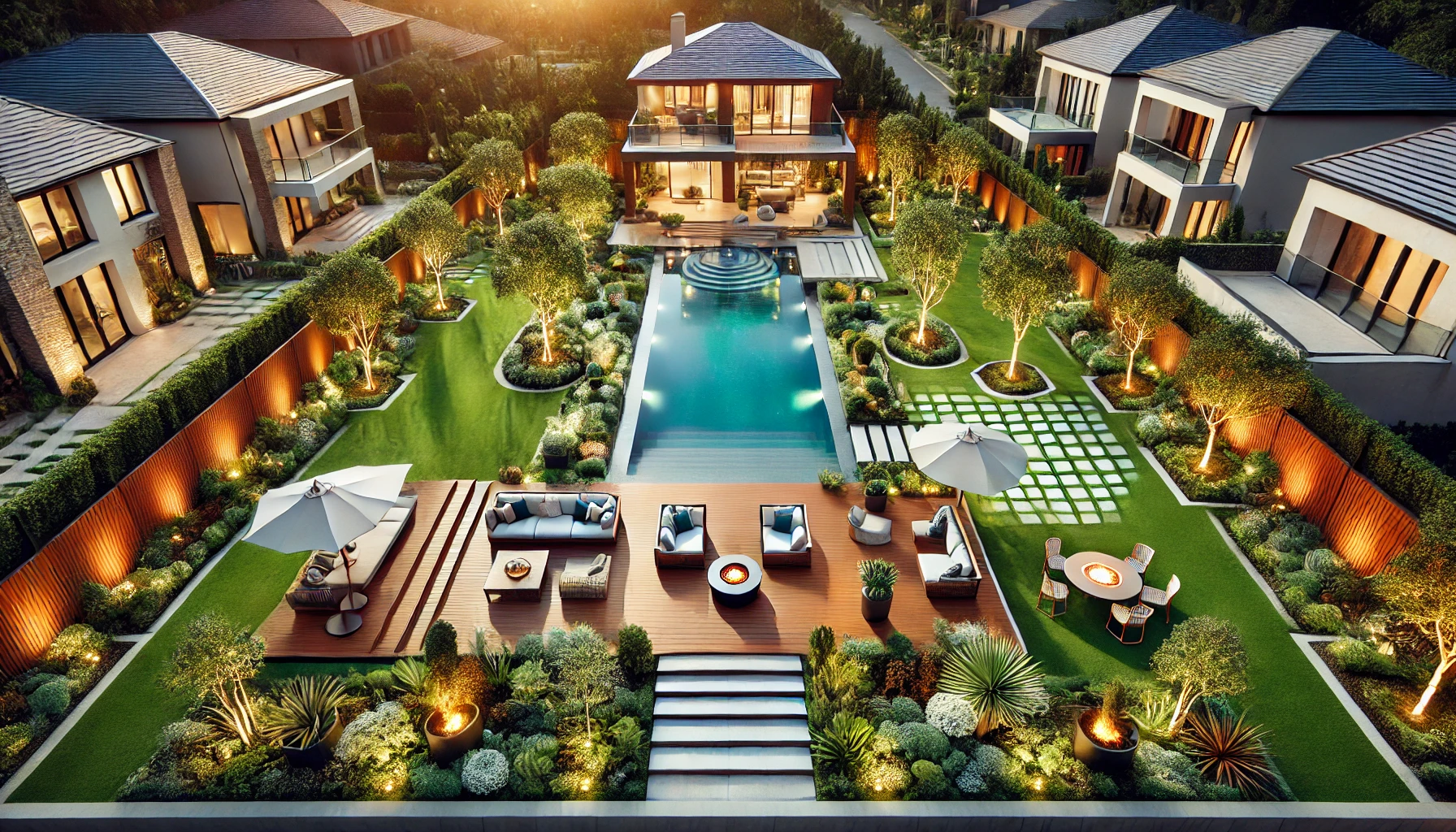
[Image: Professional Landscaping Installation in Progress]
Key Steps in Landscaping
These are the critical steps involved in creating a beautiful, functional landscape that enhances your property:
1. Site Analysis and Planning
Evaluate existing site conditions and develop a comprehensive landscape plan. Professional site analysis identifies opportunities and constraints that inform all subsequent design and implementation decisions.
- Topographical assessment: Analyze drainage patterns, slope gradients (ideal lawn slope 1-2%, maximum 3:1 for plantable slopes), and identify low points for proper water management
- Soil evaluation: Test soil pH (ideal range 6.0-7.0 for most plants), texture (loam preferred), and organic content (minimum 5% for healthy plant growth), amending as needed with specific materials
- Sun/shade mapping: Document sun exposure patterns throughout the day and seasons to select appropriate plant materials (full sun: 6+ hours direct sun, part shade: 3-6 hours, full shade: <3 hours)
2. Grading and Drainage Implementation
Reshape the terrain to manage water flow and create proper foundation for landscape elements. Effective grading and drainage prevents costly water damage while creating suitable conditions for plants and hardscape features.
- Positive drainage creation: Grade soil to direct water away from structures with minimum 2% slope (1/4″ per foot) for at least 10′ from foundations, with strategic swales to channel water to appropriate outlet points
- Subsurface drainage installation: Install French drains in poorly draining areas using 4″ perforated pipe surrounded by 3/4″ clean gravel wrapped in filter fabric, at minimum 1% slope for proper flow
- Erosion control methods: Implement temporary measures during construction (silt fencing, erosion control blankets on slopes >3:1) and permanent solutions (groundcover plantings, terracing for slopes >4:1)
3. Hardscape Construction
Install non-living landscape elements such as patios, walkways, retaining walls, and other structures. Hardscaping creates the essential framework that defines outdoor living spaces and circulation patterns.
- Base preparation: Excavate to proper depth (minimum 6″ for walkways, 8-12″ for driveways) and install compacted granular base (crushed stone or gravel at 95% compaction) with geotextile fabric in poor soil conditions
- Patio/walkway installation: Create proper slope for drainage (minimum 1/8″ per foot away from structures), with appropriate edge restraints (concrete, metal, or plastic), and joint material (polymeric sand for pavers, appropriate spacing for flagstone)
- Retaining wall construction: Build with proper base (minimum 6″ compacted gravel), backfill (3/4″ clear stone with filter fabric), drainage (4″ perforated pipe), and engineering for walls over 4′ high (often requiring permits and structural design)
4. Plant Selection and Installation
Select and install appropriate trees, shrubs, perennials, and turf. Plant material selection based on site conditions and design objectives is essential for long-term landscape success with minimal maintenance.
- Plant selection criteria: Choose species appropriate for your climate zone, soil conditions, and light exposure, emphasizing native plants (requiring 60-80% less water than non-natives) and considering mature sizes to prevent overcrowding
- Tree planting technique: Dig hole 2-3 times wider than root ball but only as deep as root ball height, backfill with native soil (not amended), create 3-4″ high water ring at drip line, and mulch 2-3″ deep (keeping mulch 2-3″ away from trunk)
- Planting design principles: Create interest through layering (trees as canopy, shrubs as understory, perennials and groundcovers as ground layer), with consideration for seasonal interest, bloom time succession, and complementary colors/textures
5. Irrigation System Installation
Design and install an efficient watering system to maintain landscape health. Proper irrigation ensures plant establishment and long-term vigor while conserving water resources.
- System design principles: Create separate hydrozones grouping plants with similar water needs, with head-to-head coverage for spray irrigation and proper spacing for drip emitters (typically 12-18″ apart for shrubs, 6-12″ for perennials)
- Component selection: Choose appropriate delivery methods for different plants (drip irrigation for shrubs and gardens at 1-4 gallons per hour, rotors for large turf areas, spray heads for smaller turf areas) and install pressure regulation (30-50 PSI) to prevent system damage
- Smart controller implementation: Install weather-based or soil moisture sensor controllers that automatically adjust watering schedules based on actual conditions, reducing water consumption by 30-50% compared to traditional timers
6. Landscape Lighting Design
Install outdoor lighting to enhance safety, security, and aesthetics. Strategic lighting extends the usability of outdoor spaces and highlights key landscape features after dark.
- Lighting techniques: Implement layered lighting approaches including path lighting (fixtures 14-18″ high, spaced 6-8′ apart), uplighting for trees and architectural features (positioned 12-18″ from base, angled at 45°), and downlighting from trees (mounted 12-15′ high for natural moonlight effect)
- System specifications: Use low-voltage systems (12-15V) with direct burial cable (minimum 12-gauge for runs over 100′), proper transformers sized at 20% above total wattage requirements, and photocell/timer controls for automatic operation
- Fixture selection: Choose fixtures with appropriate IP ratings for outdoor use (minimum IP65 for wet locations), corrosion-resistant materials (brass, copper, or quality powder-coated aluminum), and compatible LED lamps (2700K-3000K color temperature for warm, natural appearance)
7. Mulching and Final Detailing
Apply mulch and complete finishing touches to enhance appearance and plant health. Proper mulching and detailing significantly improve both the appearance and maintenance requirements of the landscape.
- Mulch application: Apply organic mulch (shredded hardwood, pine straw, or composted bark) at 2-3″ depth in planting beds, maintaining 2-3″ clearance around plant stems and tree trunks to prevent rot, covering approximately 1,000 sq.ft. per cubic yard
- Edging installation: Create distinct transitions between lawn and planting areas using appropriate edging materials (metal, plastic, stone, or spade-cut) installed at proper depth (minimum 4-5″ for metal/plastic edging) to prevent grass encroachment
- Final grading and detail work: Perform fine grading in planting beds with smooth transitions and proper drainage patterns, removing debris and creating clean, crisp edges for a professional finished appearance
Who Handles Landscaping?
Professional landscaping requires various specialized experts with specific knowledge and skills:
- Landscape Architect: Designs comprehensive landscape plans with detailed specifications, planting plans, and construction documents based on site analysis and client requirements
- Landscape Designer: Creates aesthetic planting and hardscape designs with knowledge of plant materials, design principles, and spatial relationships
- Landscape Contractor: Implements landscape plans with expertise in construction techniques, plant installation, and project management
- Hardscape Specialist: Installs patios, walkways, retaining walls, and other structural elements with knowledge of proper construction techniques and material applications
- Certified Arborist: Provides expertise in tree selection, proper planting techniques, health assessment, and preservation of existing specimens
- Irrigation Technician: Designs and installs efficient watering systems with knowledge of hydraulics, equipment selection, and water conservation techniques
- Landscape Lighting Designer: Creates lighting plans that enhance landscape features and provide safety/security with knowledge of electrical systems and lighting techniques
Time & Cost Estimates
The timeline and budget for landscape installation vary based on property size, design complexity, and material selections. Here are detailed estimates for each major phase:
| Landscape Component | Estimated Time | Estimated Cost | Key Value Points |
|---|---|---|---|
| Site Analysis & Planning | 1–2 weeks | $1,500–$5,000 | Creates foundation for successful implementation |
| Grading & Drainage | 3–7 days | $2,000–$6,500 | Prevents water damage and ensures proper conditions |
| Hardscape Construction | 1–3 weeks | $5,000–$20,000 | Provides structure and usable outdoor living space |
| Plant Installation | 3–10 days | $3,000–$15,000 | Creates visual impact and environmental benefits |
| Irrigation System | 2–5 days | $2,500–$7,500 | Ensures plant health and reduces maintenance |
| Landscape Lighting | 1–3 days | $1,800–$5,500 | Extends usability and enhances beauty at night |
| Mulching & Detailing | 1–3 days | $1,200–$3,500 | Completes professional appearance and aids plant health |
| Total Estimates | 3–8 weeks | $17,000–$63,000 | Complete landscape transformation with long-term benefits |
These cost estimations provide a general guideline and cover a range from basic to mid-tier landscaping projects. They may not reflect costs for high-end or luxury installations. For more precise estimates, consult with professionals based on your specific requirements.
Cost-Saving Tips
Optimize your landscaping investment with these expert strategies:
- Native plant prioritization: Focus on regionally appropriate native species that require 60-80% less water and maintenance than non-native alternatives, reducing annual maintenance costs by $500-$2,000 depending on property size
- Phased implementation: Develop a comprehensive master plan but install landscape elements over multiple seasons, allowing budget flexibility while ensuring cohesive final results
- Hardscape material alternatives: Consider concrete pavers ($12-$20 per sq.ft. installed) instead of natural stone ($25-$40 per sq.ft. installed) or stamped concrete ($15-$25 per sq.ft.) instead of brick pavers ($18-$30 per sq.ft.) for similar aesthetic at lower cost
- Strategic tree placement: Position deciduous trees on south and west sides of buildings to provide summer shade and winter sun, potentially reducing cooling costs by 15-35% and heating costs by 10-20%
- Plant size optimization: Install smaller plant material (1-gallon perennials vs. 3-gallon, #5 shrubs vs. #7) that will reach mature size within 2-3 growing seasons at 40-60% less initial cost
- Water efficiency investment: Allocate budget for smart irrigation controllers and high-efficiency delivery systems that reduce water usage by 30-50%, qualifying for rebates in many municipalities while lowering ongoing utility costs
Summary: Your Landscaping Action Plan
1. Start With Proper Planning
Invest time and resources in professional site analysis and comprehensive landscape design before beginning installation. This critical first step ensures that your landscape addresses site challenges, meets your specific needs, and can be implemented efficiently.
2. Prioritize Infrastructure Elements
Focus first on essential infrastructure including grading, drainage, and hardscape elements. These foundational components determine how your landscape functions and are difficult to modify later, while also providing immediate usability for outdoor living.
3. Select Appropriate Plant Material
Choose plants suited to your specific site conditions, climate zone, and maintenance capabilities. Regionally appropriate selections will establish more quickly, require less supplemental water and care, and provide greater long-term success with minimal intervention.
A thoughtfully designed and properly installed landscape enhances your property value while creating beautiful outdoor living space. Following these professional guidelines ensures that your landscape will mature gracefully while requiring minimal maintenance and resources.
Transform Your Landscape With Confidence
Track Your Progress: Monitor your landscaping milestones with our interactive tools
Stay Notified: Receive alerts for optimal planting windows, irrigation scheduling, and seasonal maintenance tasks
Step-by-Step Guidance: Follow detailed instructions on installation techniques, plant selection, and landscape care
Reduce Stress: Keep all landscape plans, plant information, and maintenance guidelines organized in one secure location
Whether you’re creating a landscape for a new property or renovating existing outdoor spaces, professional landscaping transforms your environment into a beautiful, functional extension of your home. Explore our Step-by-Step Builds, Step-by-Step Buys, and Step-by-Step Invest resources for more expert guidance.
When building your own home, always do your due diligence. Consult the professionals you’ve hired—such as your architect, subcontractors, or engineers—and confirm that your work complies with all local building codes and inspections required in your country, state, or province. Builds and Buys is for educational purposes only. Always verify with licensed professionals.
How to make a landscape design 🪴 THE STEPS 🪴 Plus DIY tips for a first time landscape design
Learn how to make a landscape design! Do you know the main steps? I hope these tips for a first time landscape design will help you get started!
Check out more informative Videos
News And Knowledge
Stay informed with the latest trends, insights, and updates in the real estate world.
Your Tools
Access your tools to manage tasks, update your profile, and track your progress.
Collaboration Feed
Engage with others, share ideas, and find inspiration in the Collaboration Feed.


